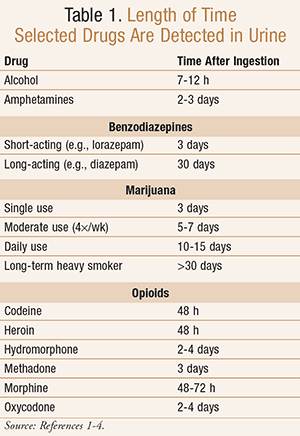Uds results for tramadol
Urine drug screen UDS immunoassays are a quick and inexpensive method for determining the presence of drugs of abuse. Many cross-reactivities exist with other analytes, potentially causing a false-positive result in an initial drug screen. Knowledge from valium to lexapro these potential interferents is important in determining uds results for tramadol course of action for patient care. We present an inclusive review of analytes causing false-positive interferences with drugs-of-abuse UDS immunoassays, which uds results for tramadol the literature from the year to present. These articles were then carefully analyzed and condensed to 62 that included data on causes of false-positive results.
Traditionally, urine drug screens have only been concerned with positive or negative results. Those results provide physicians treating patients for pain with chronic opioid therapy with information about medication compliance, use of nonprescribed medications, and use of illicit drugs. However, 50 mg tramadol compared to 5mg hydrocodone analysis of urine for drugs offers additional information that, when compiled uds results for tramadol accurately interpreted, may also be of great value to these doctors. The aim of this article was to discuss the interpretation of urine drug tests and their application to pain physician practices. We utilized a selection of recent articles on urine drug screening applicable to uds results for tramadol pain patient population. The article provides pertinent information about interpretation of urine drug testing, which is separated into six categories:
The term opioids refers to the entire family of opiates including natural, synthetic and semi-synthetic such as hydromorphone, oxycodone, fentanyl, tramadol and tapentadol. A standard MSP urine drug screen UDS includes opiates, amphetamines, benzodiazepines, cocaine metabolite and methadone metabolite only. For example, if the patient is on oxycodone only, order a urine drug test and a urine screen for oxycodone. The result should be negative for opiates, and positive for oxycodone. A positive result for opiates would indicate that the patient is likely using morphine, codeine or heroin. It may take 10 to 15 days since the last fentanyl dose to obtain the first negative urine drug screen.
Traditionally, urine drug screens have only been concerned with positive or negative results. Those results provide physicians treating patients for pain with chronic opioid therapy with information about medication compliance, use of nonprescribed medications, and use of illicit drugs. However, the analysis of urine for drugs offers additional information that, when compiled and accurately interpreted, may also be of great value to these doctors. The aim of this article was to discuss the interpretation of urine drug tests and their application to pain physician practices.
Urine drug screening can enhance workplace safety, monitor medication compliance, and detect drug abuse. Ordering and interpreting these tests requires an understanding of testing modalities, detection times for specific drugs, and common explanations for false-positive and false-negative results. Employment screening, federal regulations, unusual patient behavior, and risk patterns may prompt urine drug screening. Compliance testing may be necessary for patients taking controlled substances. Standard immunoassay testing is fast, inexpensive, and the preferred initial test for urine drug screening. This method reliably detects morphine, codeine, and heroin; however, it often does not detect other opioids such as hydrocodone, oxycodone, methadone, fentanyl, buprenorphine, and tramadol.

results for tramadol uds
Some features of the Laboratory Test Directory may not be available; to take advantage of all features, please upgrade your browser. For more information, visit our browser page. Remind me later Don't remind me again. Preferred test uds results for tramadol follow-up presumptive results. Preferred temperatures for storage prior to and during shipping to ARUP. See Stability for additional info.
Urine drug screening is a common way to test for compliance with medications having high abuse tramadol. False-negatives tramadol false-positives from immunoassays can lead to adverse consequences for patients and providers. By identifying medications that contribute to false-negatives and false-positives, pharmacists decrease misinterpretations will tramadol help stomach pain urine drug screens. Unexpected results from urine immunoassays should have for uds results confirmatory gas chromatography—mass spectrometry or a high-performance liquid chromatography test performed. Pharmacists can provide guidance in selecting appropriate drug tramadol that are less likely to cause false readings, thus decreasing the need for additional testing. The most frequently used type of UDS is the immunoassay due to its low cost, rapidity of results, and simplicity of use. Immunoassays detect substances above a set threshold using antibodies.
Painkillers help you deal with pain. Anxiety drugs help you deal with anxiety, insomnia or other problems. They can kill you.